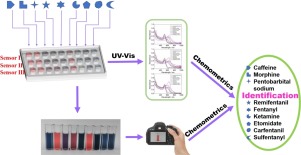当前位置:
X-MOL 学术
›
J. Pharmaceut. Biomed. Anal.
›
论文详情
Our official English website, www.x-mol.net, welcomes your
feedback! (Note: you will need to create a separate account there.)
Discrimination of narcotic drugs in human urine based on nanoplasmonics combined with chemometric method.
Journal of Pharmaceutical and Biomedical Analysis ( IF 3.1 ) Pub Date : 2020-03-20 , DOI: 10.1016/j.jpba.2020.113174 Lijuan Huang 1 , Tongtong Li 1 , Yingjun Zhang 1 , Xiaohong Sun 1 , Yongan Wang 1 , Zhiyong Nie 1
Journal of Pharmaceutical and Biomedical Analysis ( IF 3.1 ) Pub Date : 2020-03-20 , DOI: 10.1016/j.jpba.2020.113174 Lijuan Huang 1 , Tongtong Li 1 , Yingjun Zhang 1 , Xiaohong Sun 1 , Yongan Wang 1 , Zhiyong Nie 1
Affiliation

|
The detection of psychoactive substances is an important branch of modern analytical chemistry and has many legally and socially relevant implications. The use of a surface plasmon resonance (SPR)-based gene-nanoparticle system has emerged as a promising technique for the rapid and ultrasensitive detection of molecular species such as drugs of abuse in biofluids. However, the development of a viable screening tool for the detection of multiple classes of drugs in complex media is a considerable challenge because the existing techniques lack affinity toward certain species due to matrix interference. Our aim was to develop a simple optical sensor array for the classification of nine narcotic drugs in aqueous solution and human urine. The UV-vis spectra of DNA-gold nanoparticles in the presence of nine narcotic drugs (pentobarbital sodium, caffeine, morphine, remifentanil, fentanyl, ketamine, etomidate, carfentanil, and sulfentanyl) were distinctly different. Furthermore, the narcotic drugs present in aqueous solution and in human urine were classified correctly through partial least squares discriminant analysis (PLS-DA). Combination with a multi-sensor unit further improved the prediction accuracy of the PLS-DA models. The proposed method has potential for on-site drug detection and drug abuse screening.
中文翻译:

基于纳米等离子体与化学计量学方法的人尿中麻醉药品的鉴别。
精神活性物质的检测是现代分析化学的重要分支,具有许多法律和社会相关意义。基于表面等离振子共振(SPR)的基因-纳米颗粒系统的出现已成为一种有前途的技术,可用于快速超灵敏地检测分子物种,例如生物流体中的滥用药物。然而,由于现有技术由于基质干扰而缺乏对某些种类的亲和力,因此开发用于在复杂介质中检测多种药物的可行的筛选工具是一项巨大的挑战。我们的目的是开发一种简单的光学传感器阵列,用于对水溶液和人尿中的九种麻醉药物进行分类。九种麻醉药物(五苯碳酸钠,咖啡因,吗啡,瑞芬太尼,芬太尼,氯胺酮,依托咪酯,芬太尼和亚磺酰基)明显不同。此外,通过偏最小二乘判别分析(PLS-DA)对水溶液和人尿中存在的麻醉药品进行了正确分类。与多传感器单元的组合进一步提高了PLS-DA模型的预测精度。所提出的方法具有用于现场药物检测和药物滥用筛选的潜力。
更新日期:2020-03-21
中文翻译:

基于纳米等离子体与化学计量学方法的人尿中麻醉药品的鉴别。
精神活性物质的检测是现代分析化学的重要分支,具有许多法律和社会相关意义。基于表面等离振子共振(SPR)的基因-纳米颗粒系统的出现已成为一种有前途的技术,可用于快速超灵敏地检测分子物种,例如生物流体中的滥用药物。然而,由于现有技术由于基质干扰而缺乏对某些种类的亲和力,因此开发用于在复杂介质中检测多种药物的可行的筛选工具是一项巨大的挑战。我们的目的是开发一种简单的光学传感器阵列,用于对水溶液和人尿中的九种麻醉药物进行分类。九种麻醉药物(五苯碳酸钠,咖啡因,吗啡,瑞芬太尼,芬太尼,氯胺酮,依托咪酯,芬太尼和亚磺酰基)明显不同。此外,通过偏最小二乘判别分析(PLS-DA)对水溶液和人尿中存在的麻醉药品进行了正确分类。与多传感器单元的组合进一步提高了PLS-DA模型的预测精度。所提出的方法具有用于现场药物检测和药物滥用筛选的潜力。











































 京公网安备 11010802027423号
京公网安备 11010802027423号